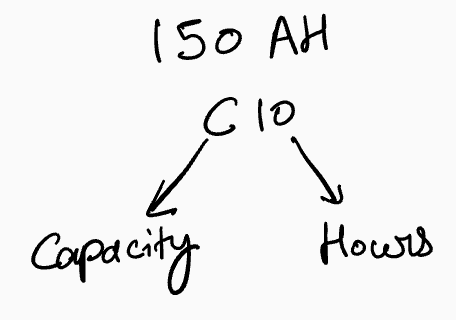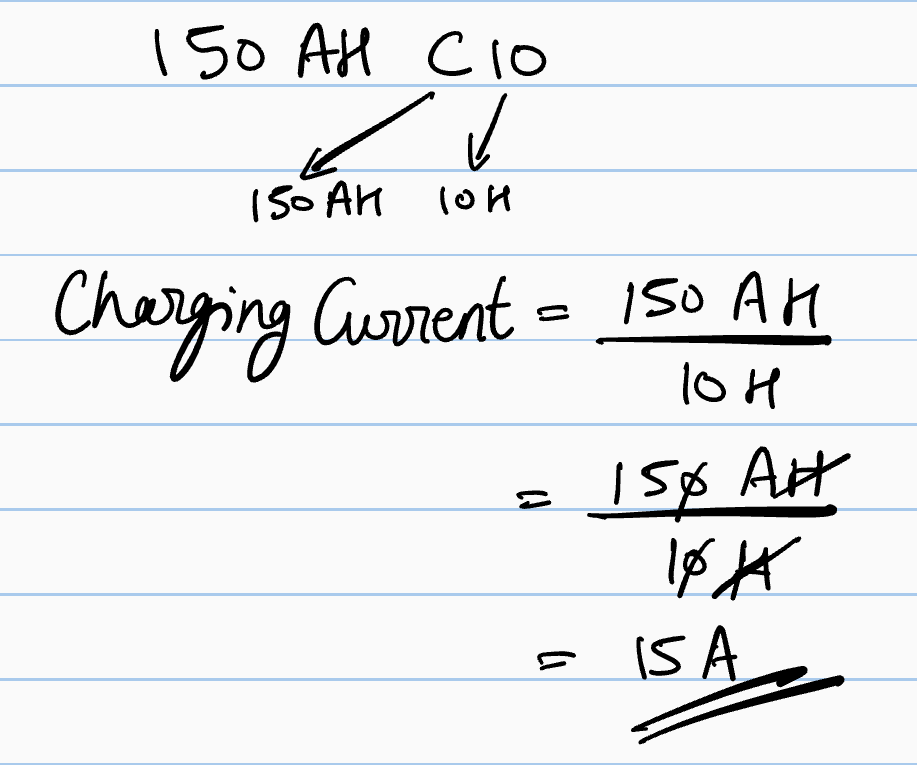
Individuals who use batteries on large scale do care about battery charging current and time because batteries are delicate and need care. In this article, we’ll check out the way to calculate the battery charging current and battery charging time. For the sake of an instance, we are taking 12 Volts 150 AH, which we use at the inverters.
Charging an inverter battery like 150 AH requires some hefty time, any newbie may make questions like:
- How much current (Amps) is required to charge a 150 Ah battery?
- How much time it will take to charge a 150 Ah battery?
Keep a note that here we are going to read some technical terms related to electronics, so clear the basics first…
- Current is denoted by the alphabet “I”.
- Amperage, Ampere, or Amps all are the same and denoted by the alphabet “A”.
- AH is Amps Hours, which means we are holding a current capacity in hours.
Ideal Charging Current.
For any kind of battery, in ideal case, the charging current should be 10% of total capacity of the battery. The battery bank will charge slowly and give you extended lifecycles. For moderate and fast charging, it can be safely extended to 15% to 20% of total capacity. Lithium-ion batteries can be fast charged without any issue.
So, if nothing is mentioned on the battery, follow the 10% for slow, 15% for moderate, and 20% for fast charging.
For some examples, I have mentioned some of the battery configurations with ideal charging currents.
| Battery Bank | 10% Slow Charging | 15% Moderate Charging | 20% Fast Charging |
|---|---|---|---|
| 80 AH | 8 AMPS | 12 AMPS | 16 AMPS |
| 100 AH | 10 AMPS | 15 AMPS | 20 AMPS |
| 150 AH | 15 AMPS | 22.5 AMPS | 30 AMPS |
| 200 AH | 20 AMPS | 30 AMPS | 40 AMPS |
| 220 AH | 22 AMPS | 33 AMPS | 44 AMPS |
| 250 AH | 25 AMPS | 37.5 AMPS | 50 AMPS |
Understanding C Rating (If Mentioned).

A battery’s C Rating is defined by the rate of time in which it takes to charge or discharge (simply, the measurement of current in which a battery is charged and discharged at). The C Ratings is denoted by a number like C5, C10, C20; where C is Capacity, and the number is time in hours.
For example, a 150AH C10 battery will charge and discharge optimally with a 15A current, we can calculate this simply by dividing the battery’s capacity which is 150AH by its C Rating which is C10, means 10 hours. For more details, other ratings are made available in the table.
| Battery AH | 150AH | 150AH | 150AH |
| Capacity (in Hours) | C5 | C10 | C20 |
| Battery AH ÷ Capacity (in Hours) | 150AH ÷ 5H | 150AH ÷ 10H | 150AH ÷ 20H |
| Charge & Discharge Current | 30A | 15A | 7.5A |
Usually, normal batteries come with C20 ratings, while solar and fast charging batteries come with C10 ratings, and the special and fast charging batteries (Lithium-ion and similar other batteries) rated with C5 ratings.
These three ratings are common and easily available in market, however, there are other ratings as well which are not common, but you can calculate for them using above-mentioned method.
Calculating Battery Charging Current.
Here we should look at the C Rating of the battery; the C Rating defines at what capacity (in amps) the battery can be charged and discharged of its total capacity, which is rated in AH (ampere-hour).
I have a 150 AH battery that has a C10 rating on it, so it should be: 150AH ÷ 10H = 15A.

AH is the rating used to tell consumers how much amperage a battery can provide for exactly one hour. This means you can drain a full 150A in 1 hour, 50A in 3 hours, and 15A in 10 Hours. You can charge a battery using more current to decrease the charging time, but not all batteries are designed that way to handle more current. However, inverter batteries are safe to handle up to 20% of its total capacity. If it is lithium-ion, then the limit is way high.
Charging a battery with more than needed and rated current may damage it or shorten its life.
So here formula is very simple, just divide the battery’s AH by C# ratings which are in hours.
I = AH ÷ C# (in Hours)Put it in an example of a 150AH C10 battery.
I = AH ÷ C# (in Hours)
= 150 AH ÷ 10H
= 15 A (theoretical answer)Practically, you’ll need a little more like +1 A or +2 A to charge a battery, bigger battery banks requires even more difference. Otherwise, it will never be able to charge itself completely to 100% levels.
If there are no C Ratings available on battery, simply fall back to the traditional method, 10%-15%-20% rule, and the calculation for that is very easy, just take out the percentage of the battery bank.
I = AH * 10%
= 150 * 10%
= 15 A (theoretical answer)
10% is considered as slow charging (normal) which is best for extended battery lifecycles, for moderate and fast charging use 15% and 20% respectively.By using any method, you’ll reach the almost same results.
Calculating Battery Charging Time.
Calculating battery charging time is easy too, all you need is AH rating and current needs which you can calculate from the above calculations.
Here we’ll see how much it will take a 150 AH battery to get charged fully.
So here formula will be a battery’s Ah rating divided by its charging current.
Time = AH ÷ ITime = AH ÷ I
= 150 AH ÷ 16 A
= 9.375 Hours (theoretical answer)Practically there are some charging losses due to which it could be more (13.125 hours) but close to the above answer. For a lead-acid battery, charging losses are 40%, so either adds another 40% value to the Ah rating or to the final hours’ value.
I have shown both the ways, just check them out carefully.
- 150 AH + (150 Ah × 40 ÷ 100) ÷ 16 A = 13.125 Hours.
- 9.375 H + (9.375 H × 40 ÷ 100) = 13.125 Hours.
You can try out this tool which is made by me personally to simplify you life.
Now using this simple technique you can calculate battery charging current and time of all sizes and various configurations without any hassle. If you still have any doubts or query regarding your configuration, you can discuss in the comment section.
Leave a Reply